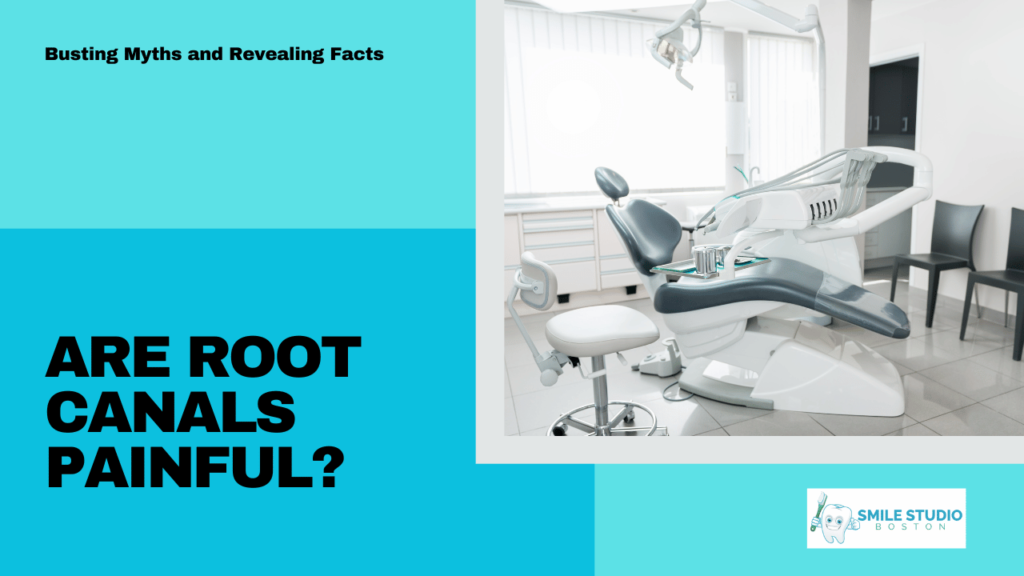Introduction
Root canal treatments, often simply referred to as “root canals”, are commonly associated with pain. This perception has been perpetuated by myths and misconceptions, leading many to fear the procedure. However, the reality is quite different.
In fact, root canal treatments are typically painless procedures. With advancements in dental technology and anesthetics, the discomfort experienced during a root canal is no more significant than that of getting a dental filling. The actual pain that patients feel is usually caused by the infection in the tooth, not the treatment itself. The root canal procedure is designed to eliminate this pain by removing the infected or inflamed pulp inside the tooth.
In this blog post, we will debunk the common myth that root canals are painful and provide factual information about the procedure. We aim to alleviate any fears or misconceptions you may have about root canal treatments and help you understand why they are a crucial part of maintaining oral health. So, let’s dive in and explore the question: Are root canals painful?
Also Read: What is Root Canal Therapy: Your Questions Answered
What Exactly Is a Root Canal?
A root canal, also known as endodontic therapy, is a dental procedure designed to save a tooth that has become infected or damaged. The process involves the following steps:
1. Removing the Infected Pulp: The dentist creates an opening in the tooth to access the pulp, which is the soft tissue inside the root canal containing nerves and blood vessels. The infected or inflamed pulp is then removed.
2. Cleaning and Shaping the Root Canal: The dentist cleans and enlarges the root canal to prepare it for filling. This is done using small files.
3. Filling the Root Canal: The cleaned and shaped root canal is filled with a rubber-like material called gutta-percha. This material strengthens the tooth when it hardens.
4. Sealing the Tooth: Finally, the tooth is sealed to prevent reinfection.
Contrary to what the name might suggest, a root canal treatment does not involve removing the roots of the tooth. Instead, it’s about treating the infection within the root canal system, thereby saving the tooth and alleviating pain, not causing it.
Also Read: Root Canal Therapy Explained: How It Saves Teeth and Prevents Further Damage
Common Misconceptions About Root Canal Pain: Are Root Canals Painful?
One of the most prevalent misconceptions about root canals is that they are excruciatingly painful. This myth has been perpetuated by outdated information and negative portrayals in media, leading many patients to fear the procedure. However, the reality is quite different.
With advancements in dental technology and anesthesia, modern root canal procedures are virtually painless. An anesthetic is usually used to numb the area, so you won’t feel anything during the treatment. In fact, most patients report feeling significant relief from pain and discomfort after a root canal.
The pain associated with root canals often comes from the infection itself before the treatment, not the treatment itself. The root canal procedure is designed to eliminate this pain by removing the infected or inflamed pulp inside the tooth. Therefore, contrary to popular belief, root canal treatments are not the cause of pain but are a solution to alleviate it.
The notion that are root canals painful is a myth. With modern anesthesia techniques, the procedure is typically painless, and any post-procedure discomfort is temporary and manageable.
Also Read: 8 Key Benefits of Teeth Cleaning: Why It’s Essential for Your Smile
The Root Canal Procedure: Step by Step
A root canal procedure involves several steps:
1. Initial Examination and X-rays: The dentist or endodontist will revisit any X-rays that have previously been taken to prepare for the procedure. They will then perform a visual inspection of the tooth and surrounding area.
2. Local Anesthesia: A local anesthetic is administered using a small needle to numb the area. You may feel a slight pinch, but there is very little pain when the anesthetic is administered. The numbing sensation will take effect almost immediately.
3. Isolation of the Tooth: A dental dam, which is a small rubber sheet, is placed over the affected tooth to protect and isolate the area. This keeps the tooth clean and dry during the procedure.
4. Accessing the Pulp Chamber: Using a specially designed drill, your dentist or endodontist will create an opening in the top of the affected tooth. This opening will fully expose the top of the tooth pulp, containing the tooth’s damaged nerve and blood vessels.
5. Removal of the Infected Pulp: The dentist will remove the tooth pulp from the inside of the tooth and the root. This part of the tooth is formally called the root canal – and it’s how the procedure got its name.
6. Cleaning and Shaping the Root Canal: The space that the pulp occupied in the center of the tooth will be carefully cleaned and widened using small dental files. Your dentist or endodontist will then irrigate the area with a variety of solutions to wash away any remaining pulp.
7. Filling the Root Canal: The cleaned and shaped root canal is filled with a rubber-like material called gutta-percha. This material strengthens the tooth when it hardens.
8. Sealing the Tooth: Finally, the tooth is sealed to prevent reinfection.
The entire root canal procedure is typically painless, thanks to the use of modern anesthesia techniques.
Also Read: Dental Ultrasonic Cleaners: Revolutionizing Oral Health Maintenance
Recovery and Managing Post-Procedure Discomfort
After the root canal procedure, as the local anesthetic wears off, you might experience mild pain and sensitivity. This discomfort is related to the cleaning process and should only last a few days. Over-the-counter pain medications such as acetaminophen (Tylenol) and ibuprofen (Advil, Motrin IB) are usually sufficient to manage this mild to moderate discomfort. It’s also advisable to avoid chewing hard foods immediately following the root canal, as this can induce more pain.
If the pain persists or worsens beyond a few days, it’s important to contact your dentist or endodontist for further evaluation and treatment.
The Truth About Root Canal Pain
The perception of root canals being painful is largely a myth. While root canals were once associated with discomfort, advances in dental technology and anesthesia have transformed the procedure into a virtually painless experience. The pain that many people associate with root canals actually comes from the infection in the tooth before the treatment, not the treatment itself. The root canal procedure is designed to eliminate this pain by removing the infected or inflamed pulp inside the tooth. Therefore, the truth about root canal pain is that the procedure itself is not painful, but rather a solution to alleviate the pain caused by dental infection.
Choosing the Right Dental Professional
At Smile Studio, we understand the importance of choosing the right dental professional for a root canal treatment. Our team of skilled endodontists and dentists are equipped to minimize any discomfort and ensure a successful outcome. Our endodontists have undergone extensive training beyond dental school, specializing in root canal therapy. This specialized education equips them with the skills and knowledge to save teeth that are damaged or infected.
At Smile Studio, we utilize the latest and most advanced equipment available. This not only improves the precision and efficiency of our dental operations but also enhances the comfort of our patients. Therefore, our expertise can further minimize any discomfort and ensure a successful outcome. Trust Smile Studio for your root canal treatment – we prioritize your comfort and dental health.
Also Read: How Much Does a Dental Cleaning Cost?
Transform Your Smile Without Fear
Root canal treatments are not the painful procedures they are often made out to be. With modern techniques and anesthesia, they are typically painless and any post-procedure discomfort is temporary and manageable. More importantly, root canal treatments play a crucial role in preserving dental health and alleviating existing pain.
At Smile Studio, we understand that the thought of a root canal can be intimidating. However, our team of skilled professionals is committed to ensuring that your experience is as comfortable as possible. We encourage you not to delay treatment due to fear of pain. Remember, the sooner an infected or inflamed tooth is treated, the better the outcome will likely be.
If you’re experiencing persistent tooth pain or other symptoms that might indicate the need for a root canal, don’t hesitate to reach out to us at Smile Studio. We’re here to help you maintain your dental health and keep your smile bright. Contact us today to schedule an appointment. Your smile is our top priority!
Don’t let fear stand in the way of your dental health. Contact us at Smile Studio today!
FAQs
1. Is A root canal painful?
Root canals are typically painless procedures thanks to modern anesthesia techniques. The pain associated with root canals often comes from the infection itself before the treatment, not the treatment itself.
2. What is a root canal?
A root canal is a dental procedure that involves the removal of the soft center of the tooth, the pulp. The pulp is made up of nerves, connective tissue, and blood vessels that help the tooth grow. The procedure involves removing the infected pulp, cleaning and disinfecting the area, and placing a filling and a crown on the tooth.
3. How long do root canals last?
A root canal can last about 11 years, but it can be extended by filling and crown, according to a large study of data from community dentistry practices. The study found that teeth that were filled and crowned after the root canal lasted about 20 years, while those that were not lasted only 6.5 years.
4. What is the main function of a root canal?
The main function of a root canal is to remove the infected or inflamed pulp inside the tooth, clean and disinfect the area, and then fill and seal the tooth. This procedure is designed to eliminate bacteria from the infected root canal, prevent reinfection of the tooth, and save the natural tooth.
5. What are the risks of a root canal?
While root canals are generally safe, they are not entirely risk-free. Risks include tooth fracture, potential low-grade and acute infections, a potential increase in systemic inflammation, and increased risks of adverse health conditions and health problems. Sometimes, the damage is too deep or the enamel is too frail to withstand the procedure, leading to loss of the tooth.
6. What’s the worst part of root canal?
The most painful part of a root canal might actually be the pain you experience before getting one. The pain that many dental patients associate with root canals is usually the discomfort that precedes the procedure rather than the root canal treatment itself.


